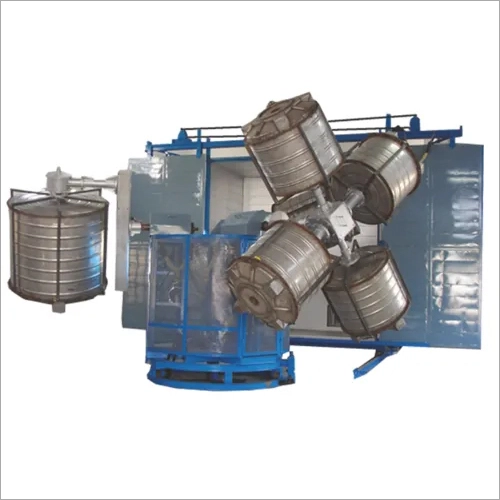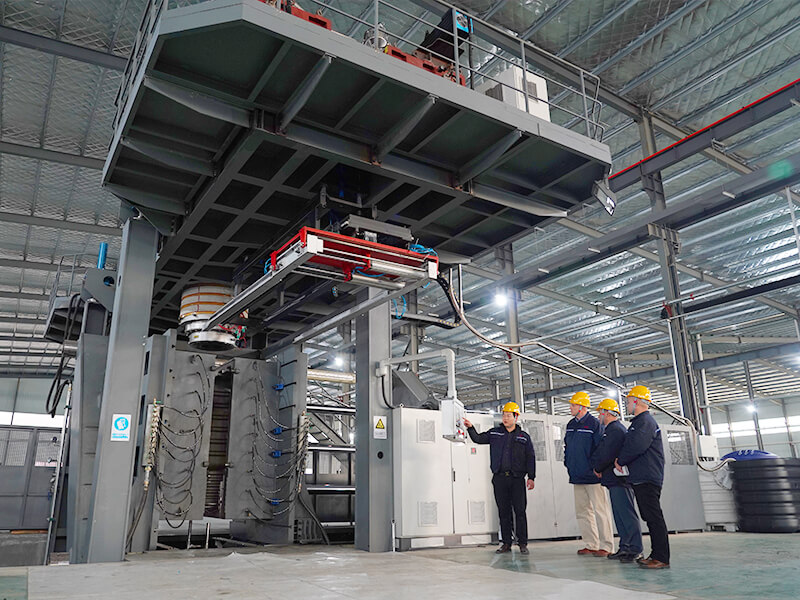Blow molding and rotomolding are two different manufacturing processes used to create plastic products. The main difference between the two processes is the way plastic material is formed into the final product.
What is blow molding?
Blow molding is a process in which melted plastic is blown into a mold cavity to create a hollow product. The plastic is melted and extruded into a parison, which is a tube-like piece of plastic. The parison is then clamped into a mold, and the air is blown into it, causing it to expand and take the shape of the mold cavity. Blow molding is commonly used to produce tanks, bottles, containers, and other hollow objects.

What is rotomolding?
Rotomolding, also known as rotational molding, is a manufacturing process used to create the hollow plastic product. In the rotational molding process, a mold is filled with a powdered plastic material such as PE, or PVC. The mold is typically made of metal, then is heated and rotated on two perpendicular axes, causing the plastic to melt and coat the interior of the mold. The rotation continues until the plastic has fully melted and fused together, forming a solid, hollow product. Once the plastic has cooled and solidified, the mold is opened and the finished product is removed.
Rotational molding is particularly useful for creating complex, hollow products that would be difficult to produce with other manufacturing techniques. such as tanks, playground equipment, and furniture. The process is also relatively simple and cost-effective, making it a popular choice for small-scale production.


Overall, both blow molding and rotomolding have their advantages and disadvantages depending on the specific application and desired end product.
Blow molding is a manufacturing process used to create hollow plastic products such as bottles, containers, and tanks. Here are some of the advantages of blow molding:
● Cost-effective: Blow molding is a cost-effective method for producing plastic products in large volumes. The mould costs are relatively low compared to other plastic molding processes. The process can be highly automated, which means it requires minimal human intervention, reduces labor costs, and makes it possible to produce large quantities of products quickly and efficiently.
● Versatility: Blow molding can be used to produce a wide variety of plastic products, ranging from small bottles to large-size tanks, among others. The process can also be used to produce products in a range of sizes and shapes, making it highly versatile.
● Consistency: Blow molding produces highly consistent products with uniform wall thickness, making it ideal for applications that require precision and accuracy. Yankang blow molding Machines make use of the America MOOG Wall Thickness Controller to guarantee the wall thickness is more uniform.
● Strength and Durability: Blow-molded products are highly durable and can withstand a wide range of environmental conditions, including extreme temperatures, and exposure to UV light, and are resistant to impact and chemicals.
● Design flexibility: Blow molding allows for a high degree of design flexibility, with the ability to create custom products with specific shapes, colors, and textures.
● Environmentally friendly: Blow molding is a more environmentally friendly manufacturing process than other plastic molding processes because it generates less waste and uses less energy.
All in all, blow molding is a highly versatile and cost-effective process for producing high-quality plastic products in large volumes.

As with any plastic molding process, rotomolding has its disadvantages and limitations:
● Limited material options: raw material used in rotomolding must be changed from granules to fine powder. Due to high temperatures within the mold, the plastic must have excellent thermal stability, limiting material selection to poly-based resins. This also increases the costs of production.
● Longer cycle times: The rotomolding process can take longer compared to blow molding, The cycle time may range from 30 minutes to several hours, depending on the size and complexity of the product. And it requires a longer cooling time to solidify the plastic material.
● Lower accuracy: The rotational molding process may not achieve the same level of precision as blow molding. The thickness of the product may vary slightly, and the details of the surface may not be as precise. Need to set perfect cycle time to avoid defects.
● High labor costs: It is hard to realize mechanization and automation in the process of rotomolding, usually needs labor to finish the process, therefore, rotomolding needs more labor than other related manufacturing processes.
● Higher mould costs: The mould costs for rotomolding can be higher than other plastic manufacturing processes, as the molds are typically made of aluminum or steel and require a longer lead time for production. And must be refurbished or replaced regularly.
Overall, rotomolding is a useful process for producing simple hollow products in large volumes. However, it may not be suitable for applications that require high accuracy, complex geometries, or a range of plastic materials.
In general, blow molding is a faster and more efficient process for creating smaller, uniform products in high volume, while rotomolding is a slower process of small-scale production. The choice between the two processes depends on the specific application, the desired product size and complexity, and the manufacturing volume.


















